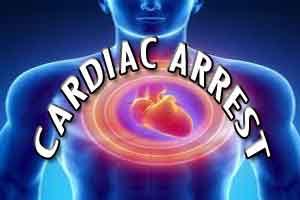- Home
- Editorial
- News
- Practice Guidelines
- Anesthesiology Guidelines
- Cancer Guidelines
- Cardiac Sciences Guidelines
- Critical Care Guidelines
- Dentistry Guidelines
- Dermatology Guidelines
- Diabetes and Endo Guidelines
- Diagnostics Guidelines
- ENT Guidelines
- Featured Practice Guidelines
- Gastroenterology Guidelines
- Geriatrics Guidelines
- Medicine Guidelines
- Nephrology Guidelines
- Neurosciences Guidelines
- Obs and Gynae Guidelines
- Ophthalmology Guidelines
- Orthopaedics Guidelines
- Paediatrics Guidelines
- Psychiatry Guidelines
- Pulmonology Guidelines
- Radiology Guidelines
- Surgery Guidelines
- Urology Guidelines
Cardiac arrest survival doubled by use of automated external defibrillator

More than 350,000 out-of-hospital cardiac arrests that occur in the United States each year, only 45.7 percent get the immediate help they need.According to new research published in the American Heart Association's journal Circulation,t has been found out that survival from cardiac arrest is doubled when a bystander stepped in to apply an automated external defibrillator (AED).It has been estimated that about 1,700 lives are saved in the United States per year by bystanders using an AED.
An international team of researchers looked at 49,555 out-of-hospital cardiac arrests that occurred in major U.S. and Canada cities. They analyzed a key subgroup of these arrests, those that occurred in public, were witnessed and were shockable. The researchers found that nearly 66 percent of these victims survived to hospital discharge after a shock delivered by a bystander. Their findings emphasized that bystanders make a critical difference is assisting cardiac arrest victims before emergency responders can get to the scene.
Among the study's results:
- Bystanders used an AED in 18.8 percent of these cases.
- Cardiac arrest victims who received a shock from a publicly-available AED had far greater chances of survival and being discharged from the hospital than those who did not; 66.5 percent versus 43 percent.
- Cardiac arrest victims who received a shock from a publicly-available AED that was administered by a bystander had 2.62 times higher odds of survival to hospital discharge and 2.73 times more favorable outcomes for functioning compared to victims who first received an AED shock after emergency responders arrived.
- Victims who received an AED shock from a bystander (57.1 percent) using a publicly-available device instead of having to wait for emergency responders (32.7 percent) had near normal function and better outcomes.
- Without a bystander using AED shock therapy, 70 percent of cardiac arrest patients either died or survived with impaired brain function.
"We estimate that about 1,700 lives are saved in the United States per year by bystanders using an AED," said senior study author Myron Weisfeldt, M.D. "Unfortunately, not enough Americans know to look for AEDs in public locations, nor are they are trained on how to use them despite great and effective efforts of the American Heart Association.
According to the American Heart Association (AHA), use of an AED is the third step in the cardiac arrest chain of survival. The first two steps in a witnessed, out-of-hospital cardiac arrest are to 1) call 9-1-1 and 2) begin immediate cardiopulmonary resuscitation (CPR).
One of the study's limitations is that it only examined bystander AED use without considering the combined impact of calling 9-1-1 and starting immediate CPR.
During a cardiac arrest, the electrical activity in the heart is disrupted. According to the American Heart Association, every second counts because without immediate CPR, the heart, brain and other vital organs aren't receiving enough oxygenated blood. For every minute without CPR, the chance of death increases by 10 percent.
Based on the study findings, Weisfeldt and his team, including lead author John Hopkins medical student Ross Pollack, would like to see greater distribution of AEDs, including equipping police with defibrillators, especially in regions where it takes emergency responders long to get to the patient.
"Bystanders have the potential to save a life," Weisfeldt continued. "This should be a great incentive for public health officials and bystanders to strive to have AEDs used on all victims of cardiac arrest."
The American Heart Association launched its Workplace Safety Training Initiative in 2017 with survey results that complement the Weisfeldt study's insights. The Association's survey found that most U.S. employees are not prepared to handle cardiac emergencies in the workplace because they lack training in CPR and First Aid. In fact, half of all U.S. workers (50 percent) cannot locate the AED at work. In the hospitality industry, that number rises to two-thirds (66 percent). More than 10,000 cardiac arrests occur annually in the workplace.
"First Aid, CPR and AED training need to become part of a larger culture of safety within workplaces," said Michael Kurz, MD, chair of the American Heart Association's Systems of Care Subcommittee and associate professor at the University of Alabama School of Medicine in the Department of Emergency Medicine. "We are certainly seeing higher public interest in this training, and our campaign calls upon decision makers in workplaces and popular public spaces such as arenas, fitness centers, hotels, and churches to place AEDs in the same locations as a fire extinguisher."
For More details click on the link: http://dx.doi.org/10.1161/CIRCULATIONAHA.117.030700
Next Story
NO DATA FOUND

Disclaimer: This site is primarily intended for healthcare professionals. Any content/information on this website does not replace the advice of medical and/or health professionals and should not be construed as medical/diagnostic advice/endorsement or prescription. Use of this site is subject to our terms of use, privacy policy, advertisement policy. © 2020 Minerva Medical Treatment Pvt Ltd